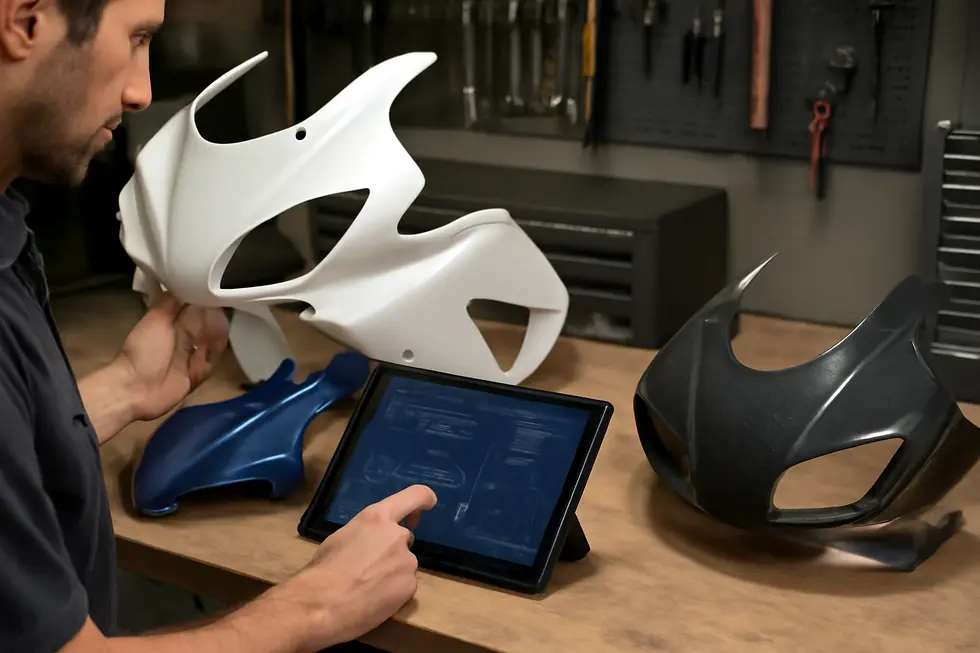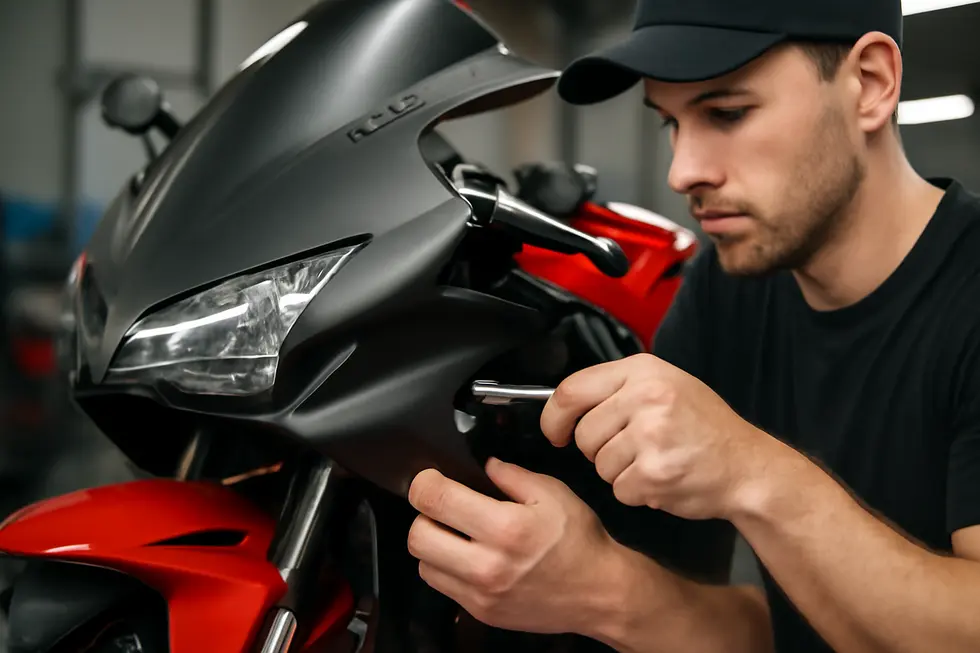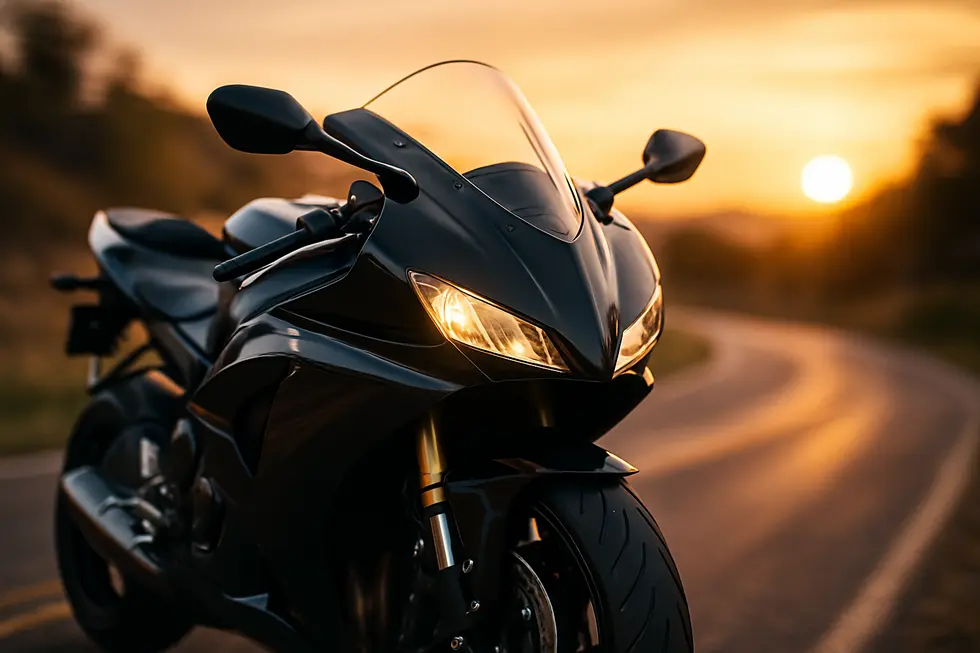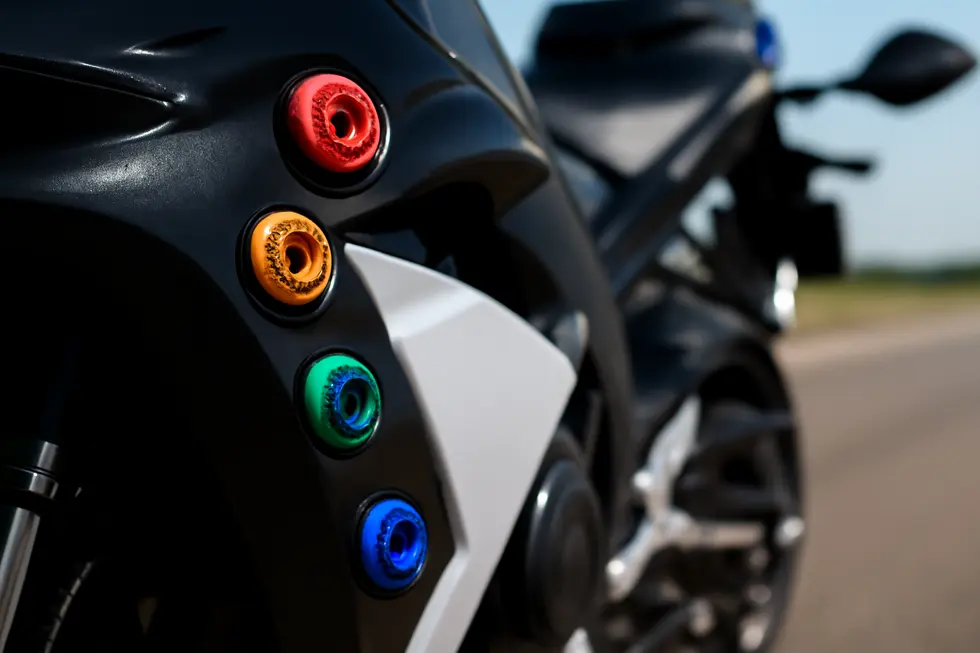Mastering Motorcycle Fairing Replacement: Materials, Market, and Performance Insights
October 14, 2025 | by summitfairings

Introduction
Motorcycle fairing replacement is an essential process that shapes both the aesthetics and performance of a bike. For business owners in the motorcycle aftermarket and repair sectors, understanding the nuances behind materials, supplier options, technical installation, and aerodynamic impact is critical to delivering value and expertise to customers. This guide breaks down the key material choices that influence durability and design, explores leading market suppliers offering OEM-level fitment, details the complexities involved in technical installation, and highlights how fairings enhance bike performance through improved aerodynamics. Each chapter builds a foundation for making informed decisions that will enhance your service offerings and customer satisfaction in motorcycle fairing replacement.
Tables of Contents
Chapter 1: Materials and Design Considerations in Motorcycle Fairing Replacement
- Balancing Material Strength, Weight, and Performance in Motorcycle Fairings
- Precision Engineering and Fitment Techniques for Optimal Motorcycle Fairing Replacement
- Optimizing Weight, Strength, and Durability for High-Performance Motorcycle Fairings
- Seamless Fusion of Style and Performance: Integrating Material Choices with Motorcycle Fairing Design
- Mastering Installation Precision and Enhancing Weather Resistance for Durable Motorcycle Fairings
Chapter 2: Major Suppliers and Market Options Shaping Motorcycle Fairing Replacement
- Leading Suppliers Driving Innovation and Customization in Motorcycle Fairings
- Exploring Material Choices and Supplier Diversity in Motorcycle Fairing Markets
- How Brand-Specific and OEM Suppliers Shape the Motorcycle Fairing Replacement Landscape
- Exploring Customization and Performance Excellence Among Leading Motorcycle Fairing Suppliers
- Navigating Wholesale Channels and Online Retail Hubs for Motorcycle Fairings
Chapter 3: Technical and Installation Aspects of Motorcycle Fairing Replacement
- Mastering Safe and Efficient Motorcycle Fairing Removal Techniques
- Essential Surface Preparation and Finishing Techniques for Flawless Fairing Installation
- Impact of Material Selection on the Technical Performance and Installation Process of Motorcycle Fairings
- Ensuring Flawless Fit and Reliable Fastening for Optimal Fairing Performance
- Ensuring Reliable Electrical Integration During Motorcycle Fairing Installation
Chapter 4: Aerodynamics and Performance Impact of Motorcycle Fairing Replacement
- Optimizing Airflow and Drag Reduction through Precision Fairing Design
- How Upgraded Fairings Enhance Fuel Efficiency and Engine Dynamics
- How Fairing Materials Shape Aerodynamic Efficiency and Riding Dynamics
- Weighing Performance Gains Against Investment: Economic Insights into Fairing Replacement
- Enhancing Rider Comfort and Stability Through Aerodynamic Fairing Design
Chapter 1: Materials and Design Considerations in Motorcycle Fairing Replacement

1. Balancing Material Strength, Weight, and Performance in Motorcycle Fairings
Material selection directly shapes the performance, durability, and aesthetic appeal of motorcycle fairings. Commonly used materials such as ABS plastic, fiberglass, carbon fiber, and polycarbonate each bring unique advantages that affect weight, strength, repair ease, and cost. ABS plastic stands out for its durability and flexibility, mimicking factory quality and withstanding heat and vibration. Fiberglass is favored by racers and customizers for its lightweight nature and simple repair process, enabling quick fixes after track damage. Carbon fiber, though more expensive, offers exceptional strength-to-weight ratios, enhancing acceleration and fuel efficiency through weight reduction and superior aerodynamic molding. Polycarbonate is primarily utilized in transparent sections like windshields, valued for clarity and impact resistance. Selecting the right material also involves considering aerodynamic performance, fitment compatibility, and potential integration of electronics. These factors combine to influence how well a new fairing protects, performs, and complements a motorcycle’s design. For deeper insights into material options and their benefits, explore affordable motorcycle fairings.
2. Precision Engineering and Fitment Techniques for Optimal Motorcycle Fairing Replacement
Achieving exact fitment in motorcycle fairing replacement hinges on meticulous precision engineering and design strategies that mirror OEM specifications or bespoke customizations. Manufacturers rely on advanced molding techniques—such as injection or vacuum forming of ABS plastic and carbon fiber layups—to replicate factory mounting points and contours within tight tolerances. This precision ensures fairings align flawlessly with the motorcycle’s frame, eliminating gaps and stress points that compromise durability or aesthetics. Furthermore, design decisions extend to surface finishes and compatibility considerations, as kits are tailored for specific models to accommodate wiring, hardware, and accessory integration. Inclusion of installation components like brackets and fasteners streamlines assembly, while careful surface preparation—like sanding and polishing—enhances paint adhesion and longevity. These fitment strategies collectively guarantee that replacement fairings not only enhance aerodynamic function but also maintain structural integrity and rider confidence. For an in-depth look at broad fairing designs and fitment options, visit your ultimate source for affordable motorcycle fairings.
3. Optimizing Weight, Strength, and Durability for High-Performance Motorcycle Fairings
Selecting the right material for motorcycle fairing replacement demands a nuanced balance of weight, strength, and durability. Common choices like ABS plastic, fiberglass, and carbon fiber each offer distinct advantages: ABS ensures impact resistance with budget-friendly durability; fiberglass allows for simpler repairs and custom modifications; carbon fiber excels with unmatched strength-to-weight ratios favored in racing contexts. Beyond materials, modern fairing designs focus on aerodynamic refinement, smoothing airflow to reduce drag and improve stability at speed. Advanced composites incorporate strength without excessive weight, crucial for maintaining handling precision and rider comfort. Proper compatibility with the motorcycle’s frame and wiring, especially when integrating lighting or electronics, is essential to preserve performance and safety. Meticulous attention to these factors ensures replacement fairings contribute both to functional excellence and the bike’s dynamic character. For riders exploring extensive options and design insights, a valuable resource is available at the in-depth motorcycle fairings blog.
4. Seamless Fusion of Style and Performance: Integrating Material Choices with Motorcycle Fairing Design
Replacing motorcycle fairings demands a nuanced blend of aesthetics and functionality. The choice of materials like ABS plastic, fiberglass, or carbon fiber directly impacts not only the durability and weight but also the visual appeal and finish quality of the replacement fairings. These materials must align with aerodynamic goals, ensuring airflow is streamlined to maintain or enhance riding stability and fuel efficiency. Meanwhile, structural integrity relies on precise mounting systems engineered to withstand dynamic stresses without compromising the bike’s frame. Equally important is achieving aesthetic consistency—whether matching original color schemes or introducing tasteful customizations—while ensuring that lighting, mirrors, and accessories integrate flawlessly. High-quality finishes protect fairings from UV damage and abrasion, contributing to long-lasting beauty. Regulatory compliance also guides design choices, safeguarding rider visibility and legal standards. This holistic integration of material science, aerodynamic design, structural soundness, and style underscores the artistry in replacing motorcycle fairings effectively. For insight into choosing and caring for high-quality fairings, readers can explore comprehensive advice available at Summit Fairings’ blog.
5. Mastering Installation Precision and Enhancing Weather Resistance for Durable Motorcycle Fairings
Successful motorcycle fairing replacement hinges on precise installation and careful material choice to ensure lasting durability. Proper alignment is crucial; misaligned components cause stress points and aerodynamic inefficiency. Fastening methods typically combine screws and clips, with OEM fasteners preferred for reliability. However, carbon fiber fairings, while offering superior rigidity and lighter weight, often require careful test-fitting due to minor manufacturing variations. Weather resistance depends heavily on material and coatings: carbon fiber benefits from advanced clear coatings that protect against UV rays, rain, and scratches, while plastics need regular UV protectants to avoid brittleness. Design affects not only fit but also maintenance ease, as overly complex fastenings can discourage inspections, risking unnoticed damage. Understanding these factors ensures fairings maintain performance and appearance under varied conditions. For further insights on selection and installation, explore expert content at the Summit Fairings blog.
Chapter 2: Major Suppliers and Market Options Shaping Motorcycle Fairing Replacement

1. Leading Suppliers Driving Innovation and Customization in Motorcycle Fairings
The motorcycle fairing replacement market is largely defined by key suppliers who deliver quality, compatibility, and variety across numerous brands. Global leaders stand out by combining precision OEM-fit designs with durable materials like ABS plastic and fiberglass. Their extensive catalogs serve Honda, Yamaha, Kawasaki, Ducati, and Triumph motorcycles among others, ensuring riders find kits that balance factory-level fitment with aesthetic upgrades. Some suppliers emphasize customizable options—allowing riders to alter colors or logos to personalize their bikes—while others focus on broad offerings of both classic and modern models for restoration and performance needs. Emerging technologies like 3D printing further push supplier capabilities toward rapid prototyping and bespoke production runs. This dynamic mix of traditional craftsmanship and innovation ensures riders can access reliable replacement fairings tailored to their exact models and riding styles. For those exploring diverse options and detailed supplier insights, comprehensive resources like the informative guides at Summit Fairings provide valuable support in navigating the market.
2. Exploring Material Choices and Supplier Diversity in Motorcycle Fairing Markets
The motorcycle fairing replacement market offers diverse options, balancing material variety with supplier specialization to fit different models and rider preferences. Common materials range from cost-effective ABS plastic, prized for its durability and ease of manufacture, to premium carbon fiber, favored for its lightweight strength despite a higher price. Fiberglass remains popular for its repairability and customizability. Leading suppliers provide extensive selections tailored to brands like BMW, Honda, and Kawasaki, with some focusing on high-performance fairings crafted from advanced composites. Online marketplaces expand access to OEM-match and aftermarket kits, allowing riders to select based on budget, material, and design needs. Choosing a reliable supplier that offers well-fitting, durable products is essential, especially when integrating fairings with motorcycle electronics and frame compatibility. For riders seeking expansive product options and expert insights, exploring dedicated fairing resources can guide an informed purchase.
3. How Brand-Specific and OEM Suppliers Shape the Motorcycle Fairing Replacement Landscape
Brand-specific and Original Equipment Manufacturer (OEM) suppliers profoundly influence the motorcycle fairing replacement market by ensuring precision fitment and material quality that mirror factory standards. Brand-centric providers tailor their components exclusively for certain motorcycle lines, delivering replacements nearly identical in appearance and performance to original fairings. OEM suppliers maintain strict control over design specifications and production, which preserves quality but can limit aftermarket innovation and availability. Consequently, major aftermarket suppliers strike a balance by offering high-quality kits that adhere closely to OEM fitment, often introducing customization or advanced materials to differentiate themselves. The resulting market caters to diverse consumer priorities, ranging from authentic OEM parts and specialized brand-focused options to versatile aftermarket kits and custom manufacturing solutions. Understanding this dynamic helps riders select replacement fairings that best align with their desired quality, aesthetics, and cost.
4. Exploring Customization and Performance Excellence Among Leading Motorcycle Fairing Suppliers
When selecting custom and performance-oriented motorcycle fairings, top suppliers blend advanced materials with design precision to meet both aesthetic and aerodynamic demands. Industry leaders provide extensive fairing collections that perfectly match original equipment manufacturer specifications while allowing for personalized touches such as custom decals and color schemes. Emphasizing quality, these suppliers utilize durable, multi-layered finishes to maintain the factory look and enhance longevity. Performance-centered vendors further refine fairings to minimize air resistance, contributing to improved bike stability and speed. For enthusiasts seeking wholesale or OEM options, marketplaces offer robust selections featuring durable materials suited to bulk purchases. Additionally, specialized manufacturers focus on unique, handcrafted fairings designed to elevate individual style and boost ride performance. Together, these market options reflect a versatile range of solutions for riders prioritizing both function and distinctive appearance. For further insight into premium custom fairing choices, consider exploring this comprehensive resource on motorcycle fairings.
5. Navigating Wholesale Channels and Online Retail Hubs for Motorcycle Fairings
The motorcycle fairing replacement market thrives on a dynamic interplay between wholesale suppliers and diverse online retail platforms. Wholesale hubs offer bulk purchasing options with an emphasis on OEM compatibility and high-quality materials, catering primarily to repair shops and distributors aiming for cost-effective stock. Online marketplaces expand access for individual riders and custom builders by providing an extensive range of replacement and aftermarket fairings, enabling buyers to compare options, verify fitment guarantees, and explore customization possibilities. Specialized manufacturers further enrich the ecosystem by delivering custom, locally crafted components aimed at enthusiasts valuing exclusivity and craftsmanship. This blend of wholesale efficiency and consumer-focused digital storefronts creates a robust supply chain that supports the wide spectrum of needs—from large-scale procurement to personalized upgrades—ensuring riders can find parts that match their specific requirements and style preferences. For a deeper exploration of fairing styles and options, consult the resource on discovering unmatched choices in motorcycle fairings.
Chapter 3: Technical and Installation Aspects of Motorcycle Fairing Replacement

1. Mastering Safe and Efficient Motorcycle Fairing Removal Techniques
Removing motorcycle fairings demands a methodical approach combined with the right tools to prevent damage and ensure a smooth replacement process. Begin by stabilizing the bike on a stand and gathering essential tools such as screwdrivers, Allen keys, and socket wrenches, tailored to the specific fasteners. Proceed by carefully unscrewing all bolts and clips, noting that some fasteners may hide beneath panels or inside recessed areas. Gentle prying may be required to disengage plastic clips without cracking panels. It’s important to remove fairing sections in a logical sequence—typically starting from the upper panels downwards—to avoid stressing connected components. Electrical connections for integrated lights or indicators should be disconnected before complete removal. After detachment, inspect mounting points for wear and clean surfaces with mild soap, avoiding abrasive materials. Labeling screws during disassembly aids reassembly accuracy. For detailed model-specific guides, exploring dedicated tutorials can offer valuable stepwise instructions tailored to precise motorcycle configurations. For more on fairing options and replacement guidance, see this resource on exploring quality motorcycle fairings.
2. Essential Surface Preparation and Finishing Techniques for Flawless Fairing Installation
Achieving a seamless motorcycle fairing replacement hinges on meticulous surface preparation and precise finishing techniques. Begin by thoroughly cleaning the fairing surfaces using mild soap and soft cloths to remove dirt and grease without damaging the plastic finish. Address any oxidation or surface dullness with controlled wet sanding, progressing from coarser to finer grit for a smooth, even layer. Polishing with a gentle rubbing compound restores gloss while avoiding heat damage. Once the surface is pristine, applying decals requires a wet method that allows easy repositioning and eliminates bubbles. For painting, a layered approach using primer, base coat, color coat, and protective top coat ensures durability and shine. Sealing with wax or ceramic coating protects against UV rays and environmental damage while enhancing gloss. Proper finishing not only elevates aesthetics but also preserves the integrity and longevity of the fairings. For detailed preparation guidance, explore comprehensive resources on how to buff motorcycle fairings.
3. Impact of Material Selection on the Technical Performance and Installation Process of Motorcycle Fairings
Choosing the right material for motorcycle fairing replacement profoundly affects both performance and installation. Carbon fiber offers unmatched strength-to-weight advantages, enhancing speed and agility, yet demands meticulous handling due to its rigidity and vulnerability to brittle fractures during installation. ABS plastic provides a robust, flexible alternative favored for everyday riding, delivering superior heat resistance, durability, and forgiving fitment that eases mounting and alignments. Acrylic blends and polycarbonate components, commonly used for windshields, combine transparency with high impact resistance and UV protection, requiring precise mounting to maintain safety and clarity. Proper fitment is critical across materials, with pre-drilled holes and OEM specifications minimizing modification needs. Understanding these material traits helps optimize the balance between weight, strength, and installation complexity, ensuring both performance integrity and rider safety. For further insights on fairing selections, explore comprehensive options at Summit Fairings’ dedicated blog.
4. Ensuring Flawless Fit and Reliable Fastening for Optimal Fairing Performance
Achieving flawless fitment and reliable fastening is essential in motorcycle fairing replacement to preserve the bike’s aerodynamics, structural integrity, and rider safety. Aftermarket fairings are precision-molded according to OEM specifications to align perfectly with the motorcycle’s frame, minimizing gaps and preventing vibration-induced wear. The material choice—ABS plastic, fiberglass, or carbon fiber—affects both fit and installation. Carbon fiber kits often include pre-drilled holes and integrated fasteners, simplifying the process. Secure fastening employs a mix of bolts, push pins, rubber grommets, and specialized clips, balancing firmness with vibration damping. Proper installation entails careful alignment, use of recommended torque settings, and consideration of wiring layouts, especially with integrated lighting. Loose or misaligned fairings can cause instability and reduce aerodynamic efficiency. For more insights on selection and fitting, exploring expert destinations for motorcycle fairings can provide valuable guidance.
5. Ensuring Reliable Electrical Integration During Motorcycle Fairing Installation
Electrical integration is a vital step in motorcycle fairing replacement, requiring precise handling of wiring to maintain safety and functionality. Removing panels reveals wiring harnesses connected to headlights, instrument clusters, and auxiliary electronics. Careful disconnection with proper labeling prevents errors during reassembly. When installing new fairings, routing wires through designated channels avoids damage from heat or moving parts, while securing cables reduces wear from vibrations. Protecting harnesses with sleeves and ensuring all enclosures are waterproof preserves reliability under varied conditions. Power and ground connections must be stable, ideally connected to the battery and a solid chassis ground to prevent electrical faults. For upgraded lighting, specialized adapters simplify integration and maintain factory wiring integrity. Testing all electrical components before final assembly is essential to verify function and avoid future issues. Using appropriate wiring kits for added accessories guarantees dependable operation and eases future maintenance. For detailed insights on fairing options, explore the Summit Fairings blog.
Chapter 4: Aerodynamics and Performance Impact of Motorcycle Fairing Replacement

1. Optimizing Airflow and Drag Reduction through Precision Fairing Design
Motorcycle fairings are engineered to streamline airflow, reducing drag and enhancing speed and stability. Their smooth, contoured shapes direct wind around the bike and rider, minimizing turbulence that impedes performance. At high speeds, even slight aerodynamic improvements translate into significant gains in acceleration and fuel efficiency. Replacing fairings with well-designed kits restores or boosts these benefits by maintaining the integrity of airflow paths. Material choice also affects aerodynamic function—lightweight ABS plastic and carbon fiber contribute to both durability and optimized weight distribution. Advanced features like integrated winglets generate downforce, improving handling during rapid acceleration and cornering. Precise fitment prevents gaps and misalignments that can create unnecessary drag, which is why selecting replacement fairings crafted to OEM specifications is critical. For riders seeking detailed options and aerodynamic insights, exploring expert resources such as the Summit Fairings blog offers valuable guidance on achieving optimal airflow and reduced drag through fairing replacement.
2. How Upgraded Fairings Enhance Fuel Efficiency and Engine Dynamics
Motorcycle fairings significantly influence aerodynamics, reducing drag and smoothing airflow around the bike and rider. When replaced or upgraded, they improve fuel efficiency by allowing the engine to encounter less air resistance, enabling it to consume less fuel during rides. This aerodynamic refinement not only benefits long-distance travel but also enhances engine performance by lessening the mechanical load required to maintain speed. Efficient fairings often incorporate design features that manage heat dispersion, helping maintain optimal engine temperature and reliability. Lightweight materials used in quality fairings contribute to this performance boost by minimizing added weight without sacrificing strength. Custom fairings can be tailored to improve these aerodynamic and thermal properties further, supporting both enhanced acceleration and top-end velocity. For riders seeking a balance between visual appeal and ride optimization, selecting a fairing that aligns with their motorcycle’s specifications is essential. Additional insights on fairing selections and designs can be explored in detail at your ultimate source for affordable motorcycle fairings.
3. How Fairing Materials Shape Aerodynamic Efficiency and Riding Dynamics
Choosing the right material for motorcycle fairing replacement directly affects aerodynamic efficiency and overall bike performance. Lightweight materials such as carbon fiber reduce the motorcycle’s mass, improving acceleration, braking, and handling by lessening suspension load and rider fatigue. Carbon fiber also maintains structural rigidity under high-speed airflow, preserving precise aerodynamic contours that minimize drag. ABS plastic, while more affordable and flexible, offers a durable but slightly heavier option that still supports sleek, OEM-quality finishes, though it may flex under stress, potentially increasing turbulence. Fiberglass strikes a middle ground, providing decent weight savings with ease of repair and shaping, ideal for moderately customized aerodynamic designs. Beyond weight, surface smoothness and the material’s ability to hold intricate shapes enable advanced aerodynamic features like winglets or air ducts, which manage airflow to reduce lift and boost stability. These benefits highlight why material selection is crucial in optimizing the aerodynamic behavior and performance gains from fairing replacement. For riders seeking detailed insights into fairing options that balance style and function, exploring dedicated sources can offer valuable guidance.
4. Weighing Performance Gains Against Investment: Economic Insights into Fairing Replacement
Replacing motorcycle fairings can dramatically enhance aerodynamics and riding performance by streamlining airflow and reducing drag, which improves speed, handling, and fuel efficiency. Advanced materials like carbon fiber lighten the bike while maximizing strength, but these upgrades often involve significant costs. Riders must balance the financial outlay against measurable benefits such as reduced fuel consumption, decreased rider fatigue, and improved lap times for competitive use. Maintenance longevity and regulatory compliance further influence economic feasibility, as durable materials may lower service frequency but require adherence to safety standards. Ultimately, a thoughtful cost-benefit analysis helps determine whether investing in high-performance fairings delivers worthwhile returns for the rider’s goals and usage, ranging from daily commuting to track racing. For a comprehensive range of affordable and customizable replacement options, exploring expert resources such as this dedicated motorcycle fairings blog can provide valuable guidance.
5. Enhancing Rider Comfort and Stability Through Aerodynamic Fairing Design
Replacing a motorcycle fairing significantly shapes aerodynamics, rider comfort, safety, and handling stability by managing airflow and drag. Well-engineered fairings streamline wind resistance, generating downforce that improves front-end stability during acceleration, braking, and cornering. This aerodynamic refinement reduces wheel lift and mechanical intervention, allowing smoother control and improved speed. Additionally, optimized air channels within the fairing increase engine cooling efficiency, preventing overheating and maintaining consistent performance during intense rides. For the rider, fairings create a pocket of calm air that reduces helmet and body wind pressure, cutting fatigue and enhancing comfort on long or fast journeys. This buffer also minimizes turbulence-induced helmet shake, increasing safety at high speeds. Durable, precisely fitted fairings not only shield mechanical components but support structural integrity, further contributing to reliable handling. Touring riders gain enhanced stability from full-coverage fairings paired with balanced weight distribution, offering security when bearing extra load. The comprehensive aerodynamic benefits explain why careful fairing replacement is essential for maximizing both performance and rider experience. For deeper insights, explore affordable motorcycle fairings at Summit Fairings.
Final thoughts
Motorcycle fairing replacement represents a multifaceted opportunity for business owners to elevate their service offerings by delivering tailored solutions that blend durability, aesthetics, and enhanced bike performance. Selecting the appropriate material from ABS, fiberglass, or carbon fiber directly influences customer satisfaction through longevity and repairability. Partnering with trusted suppliers ensures access to a broad range of OEM-quality kits that match the precise needs of popular motorcycle models. Technical expertise in installation not only guarantees seamless fitment and safety but also allows the integration of advanced features like lighting and audio. Most importantly, understanding the aerodynamic impact of fairings underscores their essential role in improving speed, stability, and fuel efficiency, reinforcing why this investment resonates with sportbike riders and enthusiasts. Embracing these considerations will empower businesses to deliver superior motorcycle fairing replacements that drive success and customer loyalty.
Ready to elevate your ride? Summit Fairings delivers premium, custom-fit fairings that blend style and durability. Whether you’re chasing speed or turning heads, we’ve got your bike covered. Don’t wait—transform your machine today. Click, customize, and ride with confidence. Your perfect fairing is just a few clicks away. Act now!
About us
undefined
RELATED POSTS
View all



